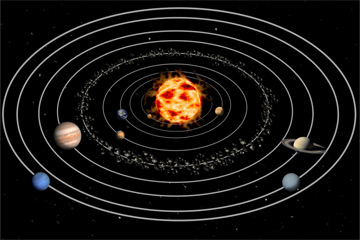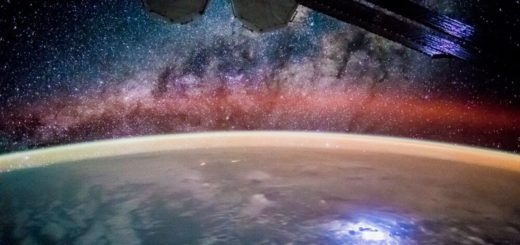Will orbital chaos cause Earth, Venus and Mars to collide?

Fair warning: If you raise exasperated eyebrows whenever someone mentions the “butterfly effect,” then you might want to stop reading now. If, however, you like to prod the black, mysterious underbelly of the universe to see what happens, then please continue.
We all know the planets of the solar system revolve around the sun in a calm, orderly fashion. In fact, the planets move with such clockwork precision that astronomers can calculate orbital characteristics — transits, eclipses, alignments — with certainty. Want a list of solar eclipses for the next 10,000 years? No problem.
Now let’s say you want to look further into the future — not thousands of years, but billions. How do those dusty astronomical tables hold up then? Not so well, if you take into account the principles of chaos theory. Chaos theory says that small inputs in an enormously complex system can produce large-scale outputs. This is the aforementioned butterfly effect: When a butterfly flaps its wings in South America, a thunderstorm can develop a few continents away — over Brisbane, Australia, let’s say. Some scientists now propose that the evolution of the solar system may adhere to chaos theory and that, way, way, way into the future, Earth could collide with either Venus or Mars.
The scientists who made this proposal in a 2009 issue of Nature — Jacques Laskar and Mickaël Gastineau — were working at the Paris Observatory. But the scientists didn’t use any of the observatory’s telescopes to generate their data. Instead, they hovered over computers, including the JADE supercomputer located at Centre Informatique National de l’Enseignement Supérieur, or CINES (National Computing Center for Higher Education and Research).
All of that computing power might seem like overkill, a scientist’s version of a muscle car, until you realize what they were trying to calculate. It has to do with Newton’s universal law of gravitation.
Remember how Sir Isaac told us that a universal force of gravitation exists between any two objects? This force is directly proportional to the masses of the objects and inversely proportional to the square of the distance separating them. He then proposed that the sun’s gravity is what holds the planets in their orbits. But, according to Newton’s own law, the planets and all of the other objects in the solar system, including moons and asteroids, must also work a little gravity magic on each other. Could the complex interplay of those forces cause the stability of the solar system to degrade over time? In the short term, no. Even over longer periods, astronomers generally believed that the solar system would remain stable.
Then, a few crazy cosmologists began to wonder if chaos theory applied to planetary orbits. If so, small changes in planetary movements could get magnified over time into something substantial. But how long would it take? Thousands of years? Millions? Billions?
Computer Code and Chaos
To answer that question, you would need to account for the movements of all the planets, as well as all of the forces being exerted as that movement occurs. Then you’d need to let the solar system run, like a clock, so that the planets cycled through hundreds of thousands of orbits. As this occurred, you would need to track key data about each planet. One of the most important pieces of data to collect would be orbital eccentricity — the measure of how far a planet deviates from a perfectly circular shape — because eccentricity determines whether two planets occupy the same airspace and run the risk of having a close encounter.
Think you would be able to run such a simulation in your head or with a desktop model of the solar system? Probably not. A supercomputer can though, which is why Laskar and Gastineau selected the JADE supercomputer to do their heavy lifting. Their inputs consisted of 2,501 orbital scenarios, where each one altered Mercury’s orbit by just a few millimeters [source: Laskar and Gastineau]. They chose Mercury because, as the runt of the solar system, it’s the biggest pushover and because its orbit synchronizes with Jupiter’s to create changes that ripple across the entire solar system.
For each hypothetical scenario, they tracked the motion of all planets for more than 5 billion years (the estimated life span of the sun), letting the computer make all of the complex calculations. Even with the high-powered CPU in the JADE unit, each solution required four months of computing to generate results.
Luckily for life on Earth, the solar system remains stable in 99 percent of the French pair’s scenarios — no planets get set on collision courses or get ejected from their orbits [source: Laskar and Gastineau]. But in 1 percent of them, where the orbital chaos has the greatest cumulative effect, Mercury’s orbit becomes eccentric enough to cause catastrophic changes in the solar system. Some of those catastrophes only involve Mercury, which could either crash into the sun or get dislodged from its orbit and flung out into space. But other, more troubling scenarios play out with Earth colliding into either Mars or Venus. A collision with Venus would occur through five steps, all of which illustrate the cumulative effects of orbital chaos [source: Laskar and Gastineau]:
First, interaction between Jupiter and Mercury in about 3.137 billion years causes the eccentricity of the latter planet to increase. This transfers noncircular angular momentum from the outer planets to the inner planets.
This transfer destabilizes the inner planets, increasing the eccentricities of Earth, Venus and Mars.
Earth has a near miss with Mars, which disturbs the eccentricity of Mars even more.
Subsequent resonances, or synchronized, reinforcing interactions, between the inner planets decrease the eccentricity of Mercury and increase the eccentricities of Venus and Earth even more.
Venus and Earth have several near misses until, at 3.352891 billion years, the two planets collide in an epic explosion that would destroy both worlds.



 Creators of mankind
Creators of mankind Description of “Tall white aliens”
Description of “Tall white aliens” Where they came from?
Where they came from? About hostile civilizations
About hostile civilizations The war for the Earth
The war for the Earth “Tall white aliens” about eternal life
“Tall white aliens” about eternal life Video: “Nordic aliens”
Video: “Nordic aliens” Aliens
Aliens Alien encounters
Alien encounters The aliens base
The aliens base UFO
UFO Technology UFO
Technology UFO Underground civilization
Underground civilization Ancient alien artifacts
Ancient alien artifacts Military and UFO
Military and UFO Mysteries and hypotheses
Mysteries and hypotheses Scientific facts
Scientific facts


















